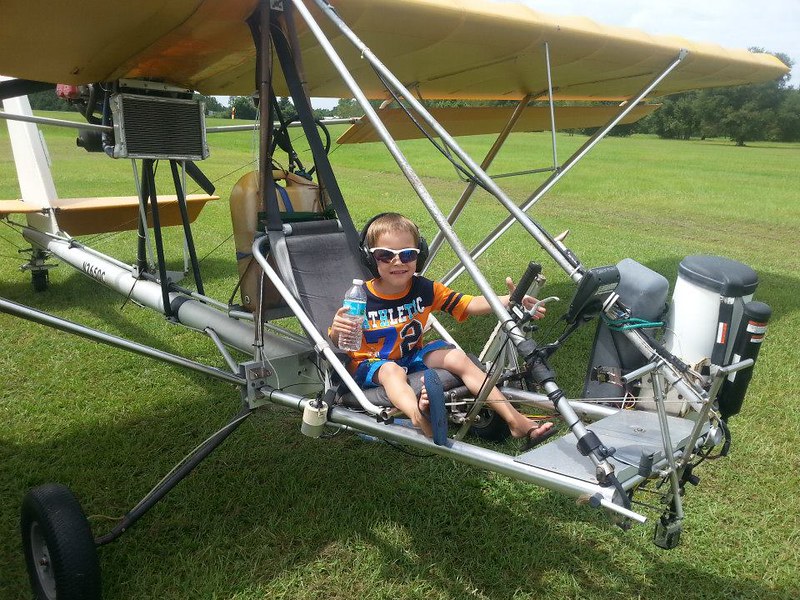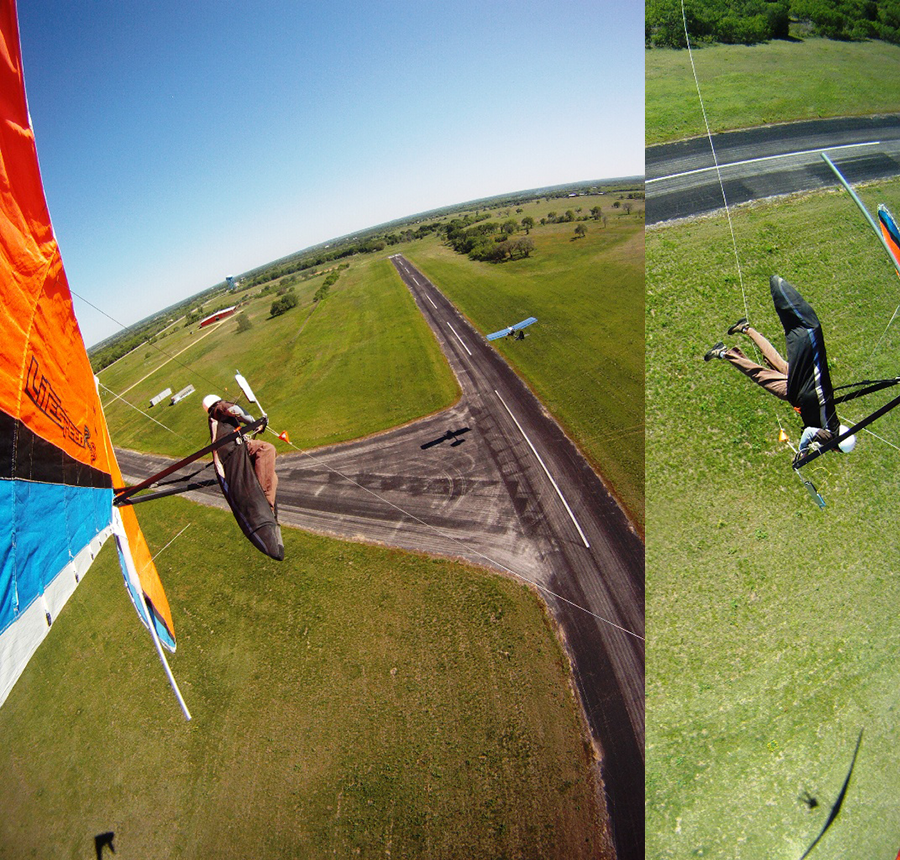Sounds like you're talking about the guy on the glider - the passenger, the one who has the same rights and responsibilities as a skydiver. How 'bout the actual PILOT? The guy who's supplying and regulating the power, the one who controls when, where, how fast and high the glider goes? How old was he and what were his ratings, qualifications, experience?Joe Gregor - 2005/07
EXECUTIVE SUMMARY:
Date/Time: 2004/06/26 ~14:00
Location: Hang Glide Chicago, Cushing Field, Illinois
Pilot: 53-year-old male, H-4
Under no circumstances say anything about the tug driver. Tugs are the most efficient and effective means of getting gliders airborne, they're about the only things that keep hang gliding viable over huge swaths of the country, when you lose them and/or their drivers u$hPa takes huge financial hits. Make this entirely about the dead glider bozo. He's no longer of the slightest use to us. (Remember the way Pat Denevan totally murdered Nancy Tachibana - 2016/04/03 - and notice that he never suffered a parking ticket's worth of repercussions from anybody or anything we know about? Still teaching on their state-of-the-art equipment at their dedicated training site at Tres Pinos.)
That's it? You tell us he had a helmet and that it wasn't full face, neither you nor anybody else tells us anything about head or face injuries, and you tell us shit about the release, whether or not it met any actual standards or had any history of failure, where and how the actuator was mounted, if there were superior properly tested and documented options available...Equipment: Glider - Moyes LightSport 14; Harness - Unknown; Helmet - non-full face
Backup release for when the primary fails? The primary release is a mechanical thing and all mechanical things fail. (Gawd, you couldn't get Jim Keen-Intellect Rooney to help you with this one?)
How 'bout the weak link? I've heard that a properly sized weak link very clearly will provide protection from excessive angles of attack, high bank turns and the like, keep you from getting into too much trouble for this form of towing. Must've been using a Tad-O-Link. (Ditto for the front end.)
No hook knife? The razor-sharp cutting tool that can slash through lines in an instant?
How 'bout the tug? Way down on Page 37 you tell us it was a Kolb but don't give us a whisper about how its towing speed stacks up against the purpose-built Dragonfly. A huge fucking deal was made about the fact that it has to tow a lot faster than the Dragonfly and the glider's tow bridle wasn't trimmed to help compensate but you're just gonna tell us it was a Kolb and leave it at that? Oh yeah - see above. There can be absolutely nothing worthy of reproach associated with the front end.
Care to mention the one...Wx: W 5 mph with thermals present
http://ozreport.com/9.179
Fatality Report
...everyone and his dog witnessed and/or experienced which was undoubtedly the single most important issue in killing the glider - configured as it was? Just kidding. Saying thermals were present was plenty good enough. It would be stupid to be towing if thermals WEREN'T present so this confirms for us that Mike wasn't overly stupid.Angelo Mantas - 2005/08/30
Soon after launching, the glider and tug flew through a strong thermal. This is confirmed by witnesses watching the tug, and the tug pilot’s reporting a strong spike in climb rate.
- Behind a faster tug than people would've preferred while thermals were present.A highly experienced mountain pilot aerotowing a newly purchased glider experienced a low-altitude lockout.
- How do we know it was a lockout? Neither the Pilot In Command nor his passenger hit a release, Arlan hit the thermal well before Mike and elected to continue the tow. How do we know that tow couldn't have been sustained if the Infallible Weak Link hadn't decided to work BEFORE Mike had gotten into too much trouble?
Is this:
26-0712

glider locked out?
29-0808

31-1011
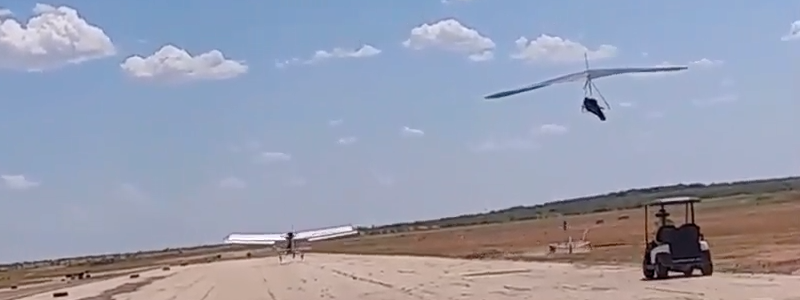
Not from what I read. What I read was that:Witness reports indicate that the glider began oscillating immediately after leaving the launch dolly.
That doesn't sound like oscillation and one can have difficulty with both pitch and roll control because of what the air is doing - and not because of what the pilot is or isn't doing. Ask me how I know. Ask......almost as soon as Mike launched off the cart, he appeared to be having difficulty with both pitch and roll control.
...Dennis Pagen if and how he knows.Bill Bryden - 2000/02
Dennis Pagen informed me several years ago about an aerotow lockout that he experienced. One moment he was correcting a bit of alignment with the tug and the next moment he was nearly upside down. He was stunned at the rapidity. I have heard similar stories from two other aerotow pilots.
They also unanimously report both planes getting hit by a thermal. The suck from the thermal as it's breaking off can do a number on a launching or landing glider. And that could've been the case here.
Doesn't sound like it was an appropriate weak link with a finished length of 1.5 inches or less. They're supposed to break BEFORE you can get into too much trouble. So how come you're not telling us what the weak link actually was...The weak link broke after the glider entered a lockout attitude.
http://ozreport.com/forum/viewtopic.php?t=559
Protow vs. weaklink
...so we can dial it down to the point at which it does what it's supposed to?Davis Straub - 2005/02/21 12:52:23 UTC
A weaklink does nothing for you in lockout, as we already established.
...back under control and Mike was able to land safely on the runway with a perfectly timed flare - just the way Mitch teaches at Quest.Once free, the glider was...
Oh, I so do hate it when my glider's attitude is unusual. As long as it's usual there's absolutely nothing to worry about....reportedly too low (50-65' AGL, estimated) to recover from the resulting unusual attitude...
- Whoa! Who could've seen that......and impacted the ground in a steep dive.
...coming.Manned Kiting
The Basic Handbook of Tow Launched Hang Gliding
Daniel F. Poynter
1974
"The greatest dangers are a rope break or a premature release." - Richard Johnson
- Good thing it impacted the GROUND in a steep dive. Things could've been really ugly if it had impacted something else.
- Why was the ground steeply diving and how hard did Mike have to dive in order to impact it?
Oh. So the ground wasn't sharp where his inconvenience terminated. At least we have that to be thankful for. Probably took it in the face what with that open face helmet he was trying to get away with.The pilot suffered fatal injuries due to blunt trauma.
- Good thing he had an Infallible Weak Link.There is no evidence that the pilot made any attempt to release from tow prior to the weak link break; the gate was found closed on the Wallaby-style tow release.
- How was the gate found on Arlan's release?
- There is no evidence that the pilot made any attempt to access his hook knife prior to the weak link break; it was was found fully secured in the sheath stitched to the right side of his harness.
- ATTEMPT to release?
http://www.chgpa.org/forums/viewtopic.php?f=2&t=3107
I have a tandem rating!!!
http://www.chgpa.org/forums/viewtopic.php?f=2&t=3391Lauren Tjaden - 2008/03/23 22:20:15 UTC
When Jim got me locked out to the right, I couldn't keep the pitch of the glider with one hand for more than a second (the pressure was a zillion pounds, more or less), but the F'ing release slid around when I tried to hit it. The barrel release wouldn't work because we had too much pressure on it.
Anyhow, the tandem can indeed perform big wingovers, as I demonstrated when I finally got separated from the tug.
More on Zapata and weak link
Thanks for confirming for us that going for a Wallaby-style tow release requires a sacrifice of control in a critical situation and achieving blow is a real iffy proposition anyway.Paul Tjaden - 2008/07/22 04:32:22 UTC
I have never had a lockout situation happen so quickly and dramatically and had no chance to release as I have always thought I could do.
- Well, guess we got everything related to the unfortunate tow thoroughly dealt with. Now let's get on with all the really important background stuff.
What did the fuckin' launch have to do with anything? You said he was at least fifty feet up before things went relevantly south. The launch was ancient history before that point.Reports indicate that this was only the second time the accident pilot had flown this glider (a replacement for his Xtralite 137), and that the previous flight had taken place at a foot-launch site.
- When do you think his next one will be?The pilot's last reported aerotow flight took place in October of 2003.
- His driver's last reported aerotow flight is gonna take place in three days into September of 2005 - a wee bit over two months after this bullshit excuse for a report in this bullshit magazine hits the stands. And he's gonna take a just-about-to-solo 32 year old US ski team member with him. And there are probably issues that you deliberately buried in this bullshit report involved in that one. You sleep OK with that?
Stop the presses.Conditions: The accident flight was initiated from an airfield employing a dolly.
I'm guessing flat and hard with little to no snow covering. That would account for the suffering of fatal injuries due to blunt trauma.Runway surface conditions present at the time at the time of the accident are unknown.
Whoa! Good thing there were no actual thermals breaking off right after launch. All bets are off when that happens. Maybe it would a be a good idea to stake the sides of the runway with wind streamers to guard against a launch at a really inopportune time.Winds were light (W at 5 mph) and crossing from the left. Low-level thermal-induced turbulence was present.
Whoa! You'd have thunk he'd have had better skills and judgment. Maybe we should be taking a closer look at some of his ratings officials.Logbook: The accident pilot held a USHGA H-4 rating (obtained in 1983) with the following special skill signoffs: TUR, AT, AWCL, CL, FL, FSL.
And although Angelo's meticulously detailed incident report IS we're gonna ignore it and pad this report with a bunch of irrelevant useless crap to create an illusion of u$hPa being a legitimate responsible sport aviation organization. What's left of that fraud is gonna implode at Jean Lake in the early afternoon of 2015/03/27.Detailed logbook information is not available...
- Too bad he didn't stay that course. Much safer due to its inherent simplicity....but the vast majority of his time reportedly involved ridge soaring via foot launch.
- And none of that would've been thermal time so he'd have been totally unprepared to react instantly, correctly, authoritatively in an AT situation in mid-day conditions on a day during which thermals were present.
What WAS he thinking?The accident pilot had flown one previous time on the accident glider...
I heard a rumor that they can tow at a slower, more hang glider friendly speed. Any truth to it?...a two- to three- hour ridge soaring flight. He had performed numerous aerotow launches using his previous glider (a smaller Moyes Xtralight) behind a Dragonfly tug.
How 'bout after? Oh yeah... Fatal injuries. Sorry.Medical: There were no known pre-existing physical conditions prior to the accident flight.
Bull fucking shit. Oscillation is OVER controlling - and you can do it all the way up in theory. A lockout occurs when your control authority is phyisically overwhelmed by misalignment.Synopsis: The accident pilot launched via dolly while being towed by a Kolb ultralight. Witnesses observed the pilot to oscillate first right, then left, immediately after leaving the cart.
Oh. He CORRECTED back to wings level after reaching a near-lockout roll attitude? He OSCILLATED to the right, brought it back to center level, then decided to OSCILLATE to the left and brought it back to center level. That's not an oscillation your describing. I know 'cause I've oscillated my HPAT 158 on AT behind a Dragonfly at Ridgely.In both cases the pilot corrected back to wings level after reaching a near-lockout roll attitude.
Oscillation can only be Pilot Induced. We were at maybe two hundred feet, the relevant air was smooth as glass, I was overcontrolling - after tons of AT time in all kinds of violently turbulent conditions, the tug slowed down for me, I got things back together, the tow was resumed just fine. If we'd been low and I'd felt a need to I could've safely and easily aborted the tow with both hands on the control bar just as I'd started coming back from an extreme.
And by the way... The tug wasn't the slightest bit fazed by any of this.
Arlan reports a spike in climb rate. Was that due to turbulence? If so shouldn't we be putting more effort into coring it?Glider and tug both encountered turbulence while still below 100' AGL.
That's GOTTA be a Tad-O-Link. Simultaneously locks the glider on a path to certain death while overriding the focal point of the tug's safe towing system and overloading the tug's release and the tug driver's will to attempt using it.Witnesses observed the glider pitch up "radically" and begin rolling to the left while still under tow.
Like this?:The weak link broke with the glider in an extreme left bank...
1-1305
http://farm4.staticflickr.com/3866/14552665986_6a87882667_o.png
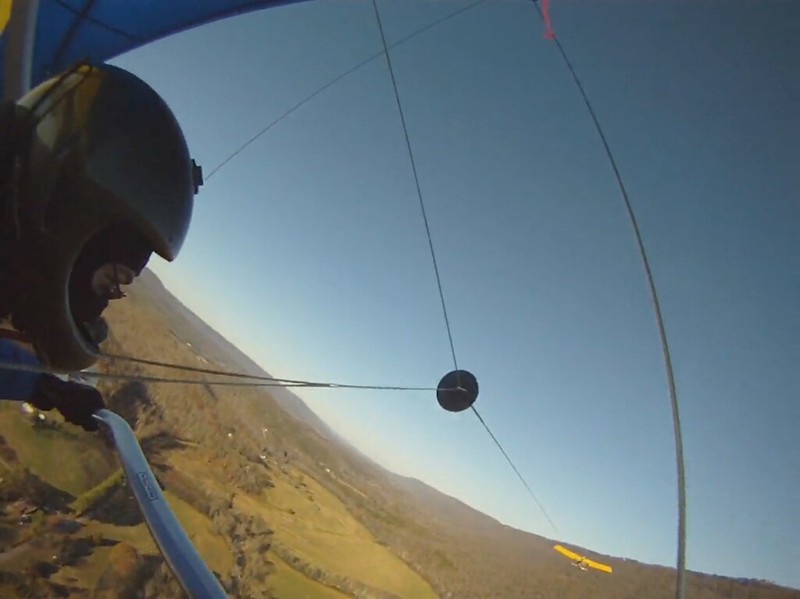
2-1306
http://farm8.staticflickr.com/7258/13851486814_77efdf1004_o.png
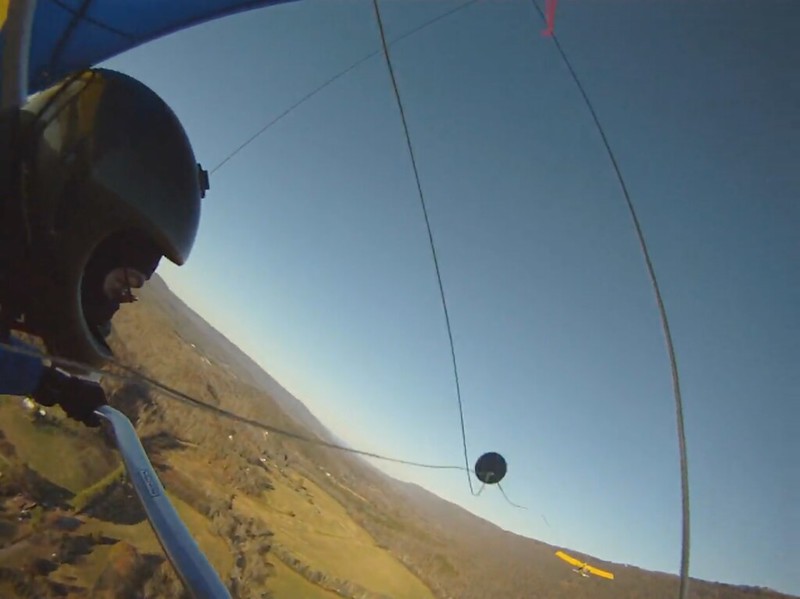
061-03627...and the glider continued to roll left to enter a near-vertical dive.
http://live.staticflickr.com/65535/49973150233_be7ab2e04e_o.png
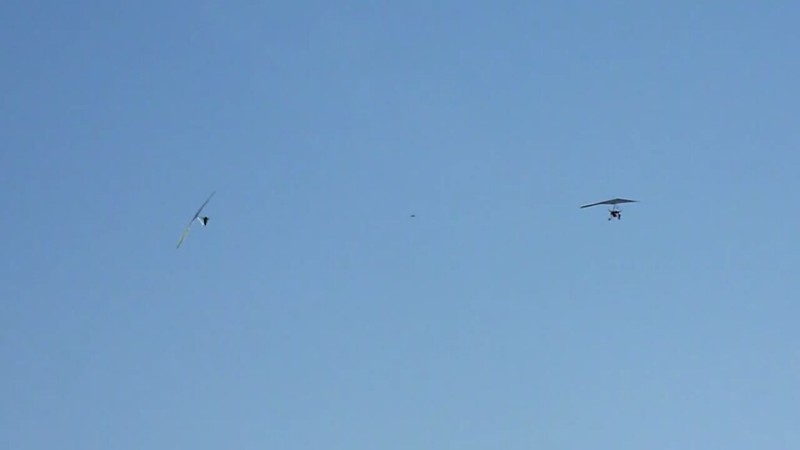
062-03708
http://live.staticflickr.com/5606/15600335029_3c234e6828_o.png
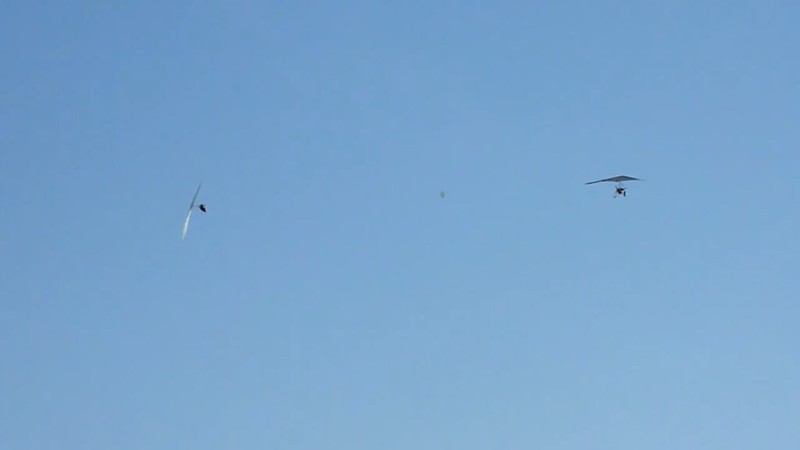
063-03805
http://live.staticflickr.com/8256/15786161205_1b6de38d88_o.png
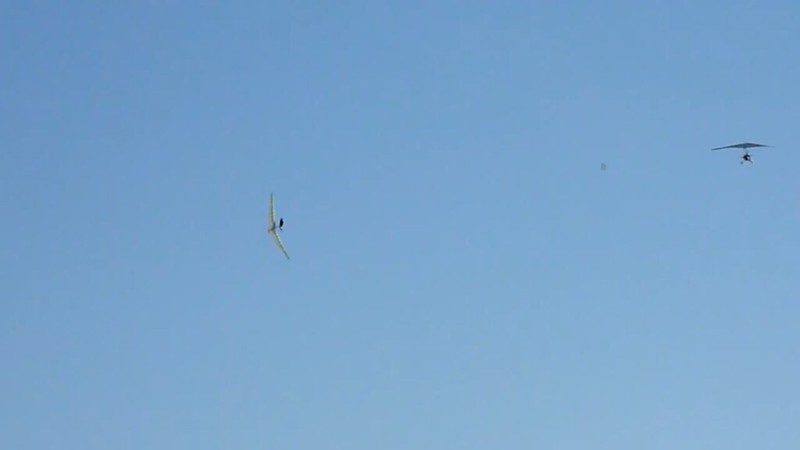
'Cept with the runway a lot closer, huh Joe?
No...The glider struck the ground left wing first with a near-90-degree pitch attitude. Assistance was immediate, but the pilot died from severe blunt force trauma.
http://ozreport.com/9.179
Fatality Report
...he didn't.Angelo Mantas - 2005/08/30
Mike suffered a broken spinal cord and was probably killed instantly.
Who cares?Airframe: The glider control frame was found intact with one downtube bent. The keel and one leading edge were broken off near the noseplate junction.
Well fuck... What WAS Mike thinking? He'd have obviously been fine if he'd had a tail fin. And/Or a full face helmet.The glider was not equipped with a tail fin.
Seven months ago Robin Strid's...The tow release was found with the gate in the closed and latched position.
http://ozreport.com/pub/images/robinsshacklebig.jpg
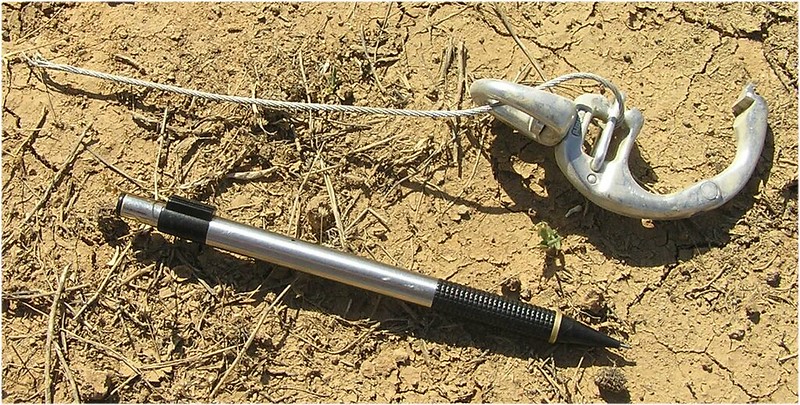
...is gonna be found with the gate in the opened and unlatched position.
http://www.flickr.com/photos/aerotowrelease/8318769461/
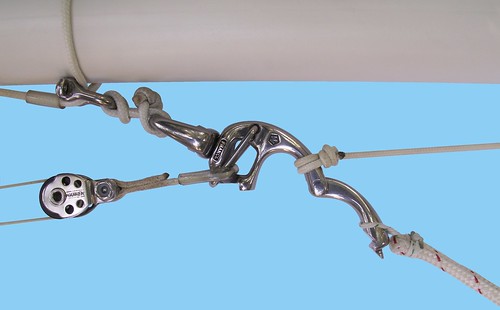
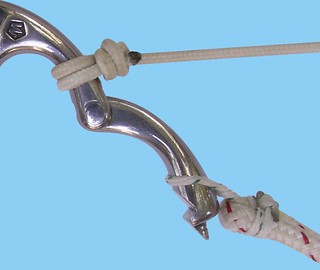
http://www.flickr.com/photos/aerotowrelease/8318781297/
How much differenence in the results are we seeing?
What a bitch. If only there'd been some electronically recorded flight information available for analysis in this accident we'd have REALLY been able to start getting a handle on this safety thing.Analysis: No electronically recorded flight information (GPS or barograph) was available for analysis in this accident.
But fear not, kids. We're gonna redact the part about both planes getting hit by a thermal which wouldn't have happened if there'd been streamers along the runway and wouldn't have mattered if Arlan had aborted the tow when he got hit.As a result we are left with eyewitness accounts and post-crash damage analysis in order to determine what likely occurred in this accident.
Really? The marketer of the Wallaby-style tow release assures us that we'll be experiencing the weak link break BEFORE entering the lockout.Eyewitness accounts both in-flight and on the ground all agree that the glider entered a lockout prior to experiencing a weak link break below 100' AGL.
What's the difference between a bridle and a V-bridle?The pilot employed a dual V-bridle...
Which one? The top or the bottom?...system using the pilot hang point as one terminus.
Good thing there's no controversy about the focal point of his safe towing system. Otherwise you might have to extend this report up to at least fourteen pages - the way Dr. Trisa Tilletti will seven years plus a month after this report.There is some controversy concerning the efficacy of this arrangement given the pilot's weight and skill level, but it is not an unusual configuration for towing a hang glider of this class.
And be careful ONLY to mention pitch pressures and say absolutely NOTHING about bar...Lower performance gliders commonly use an upper attachment point somewhere along the keel forward of the attachment point, to help reduce the high bar pressures present under tow.
http://1.bp.blogspot.com/-2lk6hbjuJ-c/Ujh-ENPLQrI/AAAAAAAA3IQ/vh46chqQX4M/s1600/JRS_0542.JPG


...position. We don't wanna upset the pro toads and instructors teaching pilots how to tow one point safely.
- Bullshit.This arrangement probably adds some positive yaw stability to the system, also.
- Tell me how yaw stability was an issue in this or any other lockout incident. The issue is ROLL stability - and a towed hang glider doesn't have any.
Yeah. You'd hafta do something like:Higher performance gliders exhibit significantly less bar pressure, and access to the keel forward of the hang point is much more difficult to obtain due to sail design.
http://www.flickr.com/photos/aerotowrelease/8305999131/
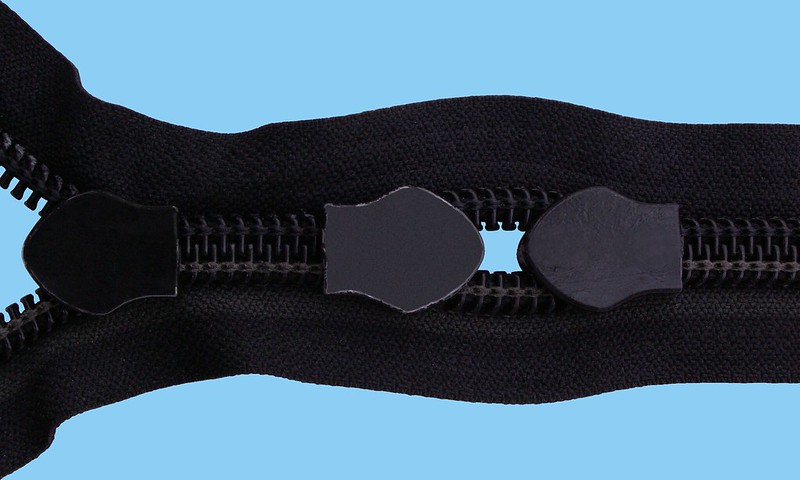
And that technological advance is still another decade out for the people actually working on things. But I'm pretty sure I'd done that modification on my own glider prior to that incident.
Yeah, you have to have TONS of experience to fly higher performance gliders. 'Specially to be able to safely land them in narrow dry riverbeds with large rocks strewn all over the place.The pilots of these gliders are also generally more experienced.
Actually... An upper bridle attachment ANYWHERE is virtually nonexistent with these designs. Davis doesn't even permit an upper attachment in u$hPa comps because it doesn't fit the definition of the appropriate bridle he sells.Thus an upper bridle attachment at the hang point is more common with these designs.
Yeah, that would CERTAINLY account for the radical pitch-up we're all agreed upon having happened. Case closed. Now let's discuss the stellar success the Aussie Methodists have had in preventing unhooked launches and how we might be able to better evangelize their message.The accident glider was new to this pilot, a bit larger, and perhaps also somewhat less stable on tow than the wing he was accustomed to flying.
What at total fucking idiot. An AT rated 1983 Hang Four hooking up a new glider two point and going towing in mid-day conditions on a day during which thermals were present. How did this moron ever manage to get rated for anything and who rated him? And why was Arlan towing him?The pilot was towing in mid-day conditions on a day during which thermals were present.
Suck my dick, Joe.The combination of all of these factors could have placed a premium on the accident pilot's aerotow skills.
- Wow. This isn't just the PROBABLE Cause. You totally nailed it.Probable Cause: Failure to maintain aircraft control while maneuvering close to the terrain.
- I missed the part where anybody was MANEUVERING. Were there pylons...
334-160414
http://c2.staticflickr.com/2/1847/43259852245_563be59bb5_o.png
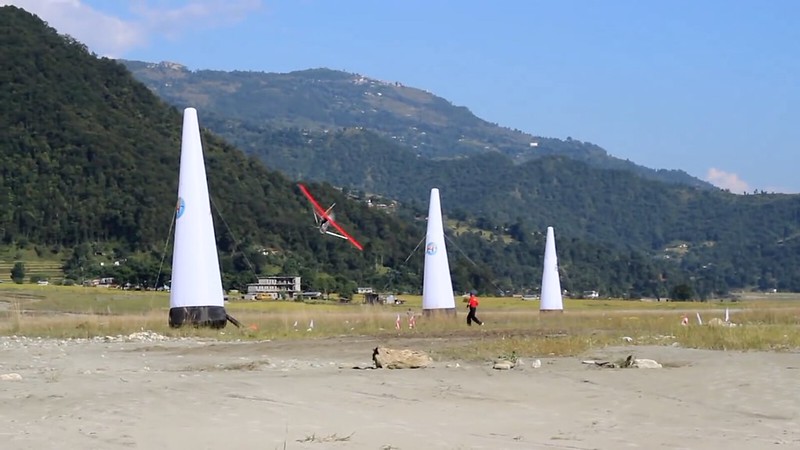
...set up on the runway through which they were weaving in order to hone their AT skills? They weren't MANEUVERING - asshole. They we're launching an AT and trying trying to avoid maneuvering like the fuckin' plague.
Yeah, ya really gotta watch out for those MITIGATING circumstances. They're the real killers whenever pilots fail to maintain aircraft control while maneuvering close to the terrain.Mitigating circumstances include possible low-level turbulence inducing conditions beyond the pilot's skill and proficiency level to correct.
Whoa! Who'da thunk. I'll bet landing is another one. 'Specially while your maneuvering with mitigating circumstances.Discussion: Launch is one of the most dangerous phases of flight for a hang glider.
Show me some videos of pilots maneuving on launch. And no, exiting the setup area on the way to the ramp doesn't count.During this phase the pilot is generally constrained to maneuver close to the ground while below, at, and just above stall speed.
A dolly MITIGATES dangers of an AT launch? Why would any sane person use one then?Aerotowing using a dolly mitigates some of these dangers by eliminating the need to transition from ground-handling below stall speed to active flight just above stall speed...
You're getting paid by the word, right? But heavily penalized for using any words of actual substance....all while manually maintaining physical separation between the wing and nearby terrain with the pilot's legs.
However, aerotowing introduces other dangers related to the fact that the pilot must separate cleanly from the cart (dolly) and actively manage an unstable flight system during the entire tow.

Wow. If only Mike had known that successful recovery from a lockout attitude is problematic, at best, below the first hundred feet of the tow he probably wouldn't have maneuvered into a lockout attitude below the first hundred feet of the tow. Probably would've waited until the second or third hundred feet - 'specially with a dolly mitigating some of these dangers.These issues are critical during the first 100' of the tow, below which successful recovery from a lockout attitude is problematic, at best.
- How 'bout a release that doesn't incorporate an attempt into the procedure for actuation? Just kidding.Use of devices that add stability to the system - such as a tail fin - should be highly encouraged for pilots making the transition from another launch method.
- He wasn't making a TRANSITION from another launch method. He was AT RATED. So is that supposed to mean something or not? Pick one. Either way you and that shit hole of an organization for whom you're working lose.
See above.Recommendations: Exercise great caution when learning to fly using a new launch method, or when launching with new equipment.
What's u$hPa's currency policy? Keep paying your dues or they shit can all your qualifications?Pilots should treat each launch method as an independent maneuver for the purposes of training and currency.
Go fuck yourself. Anybody with solid Two level proficiency can pull off any of that in reasonable conditions. And when conditions get too unreasonable nobody can.Pilots should not expect proficiency in one launch method to automatically transfer in whole or in part to proficiency in another launch method. Slope and ramp launching, assisted windy cliff launching, aerotow, platform and scooter tow, are all very different maneuvers, each requiring different skill sets.
- The u$hPa Pilot Proficiency System recognizes a separate special skill signoff for several of these maneuvers to allow their commercial operators to get inside of your wallet.This is why the USHGA Pilot Proficiency System recognizes a separate special skill signoff for several of these maneuvers.
- Mike HAD the fuckin' rating - and ended up instantly totally dead anyway. This organization is incompetent and corrupt and you can't trust anyone in it or anything about it.
Guess you've never done a balloon drop.Every launch method involves a transition from non-flying to flight while very close to the terrain.
Keep up the great work, Joe. It's through the efforts of top notch individuals such as yourself that the sport's in its current death spiral maneuver.This puts a great premium on pilot skill and proficiency. When learning a new launch method, even highly experienced pilots should consider themselves equivalent to a new H-2 with regards to that particular maneuver, until they have accumulated a level of experience at that launch method commensurate with their general flying skills.
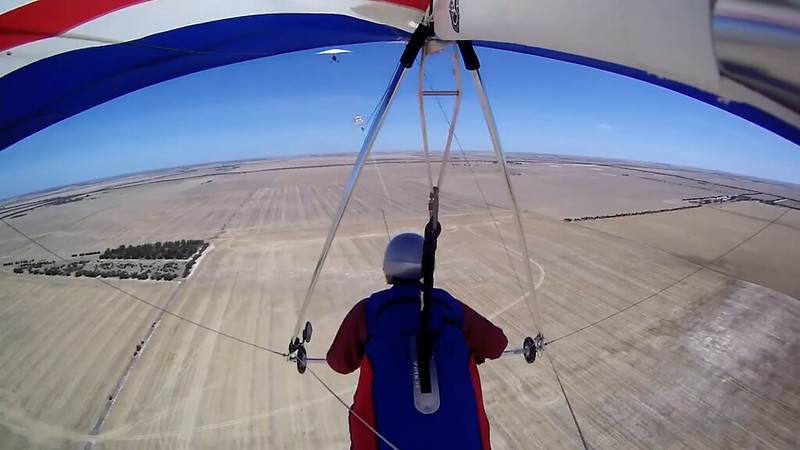
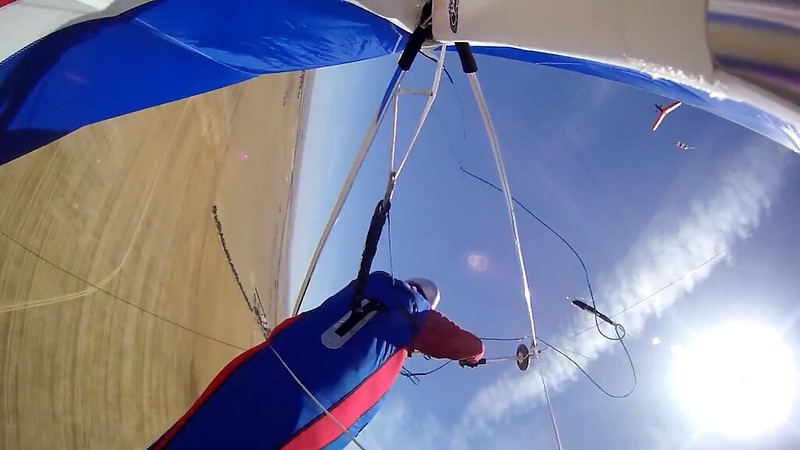
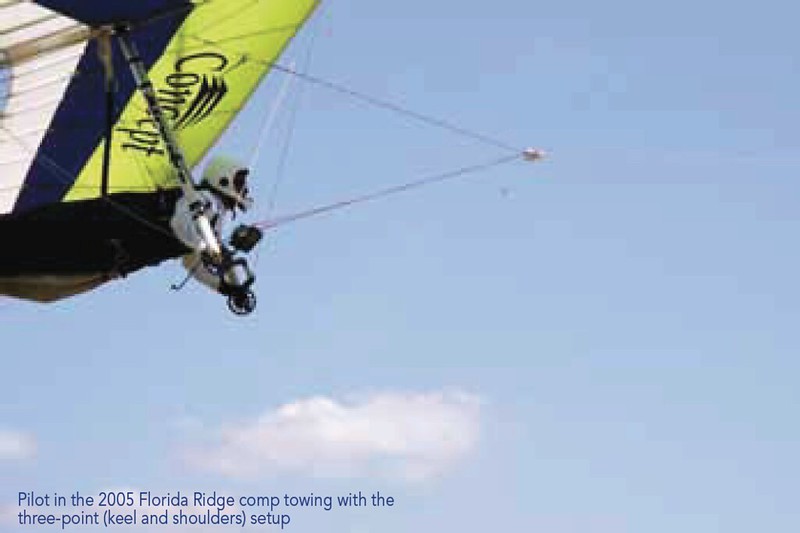
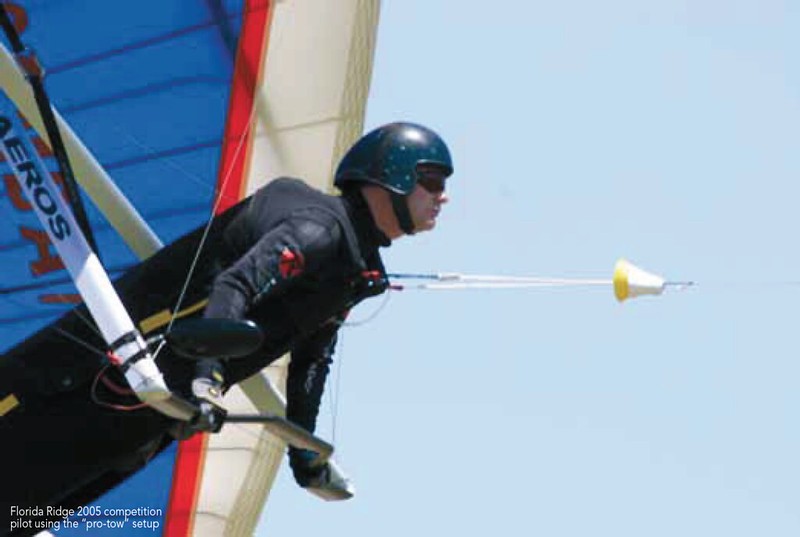

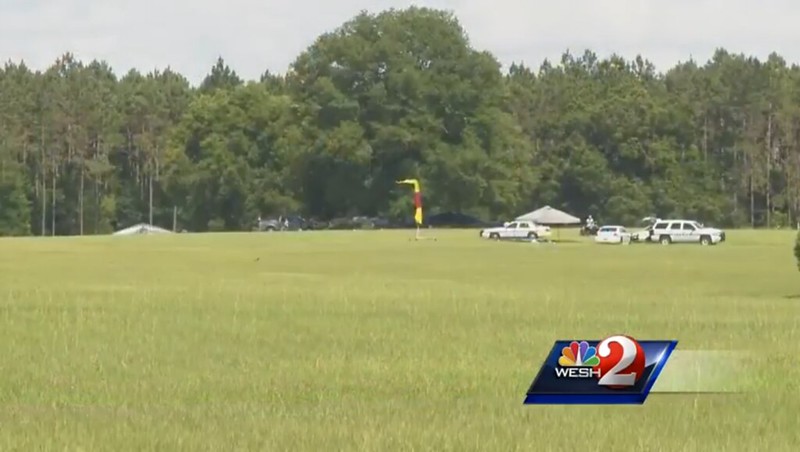

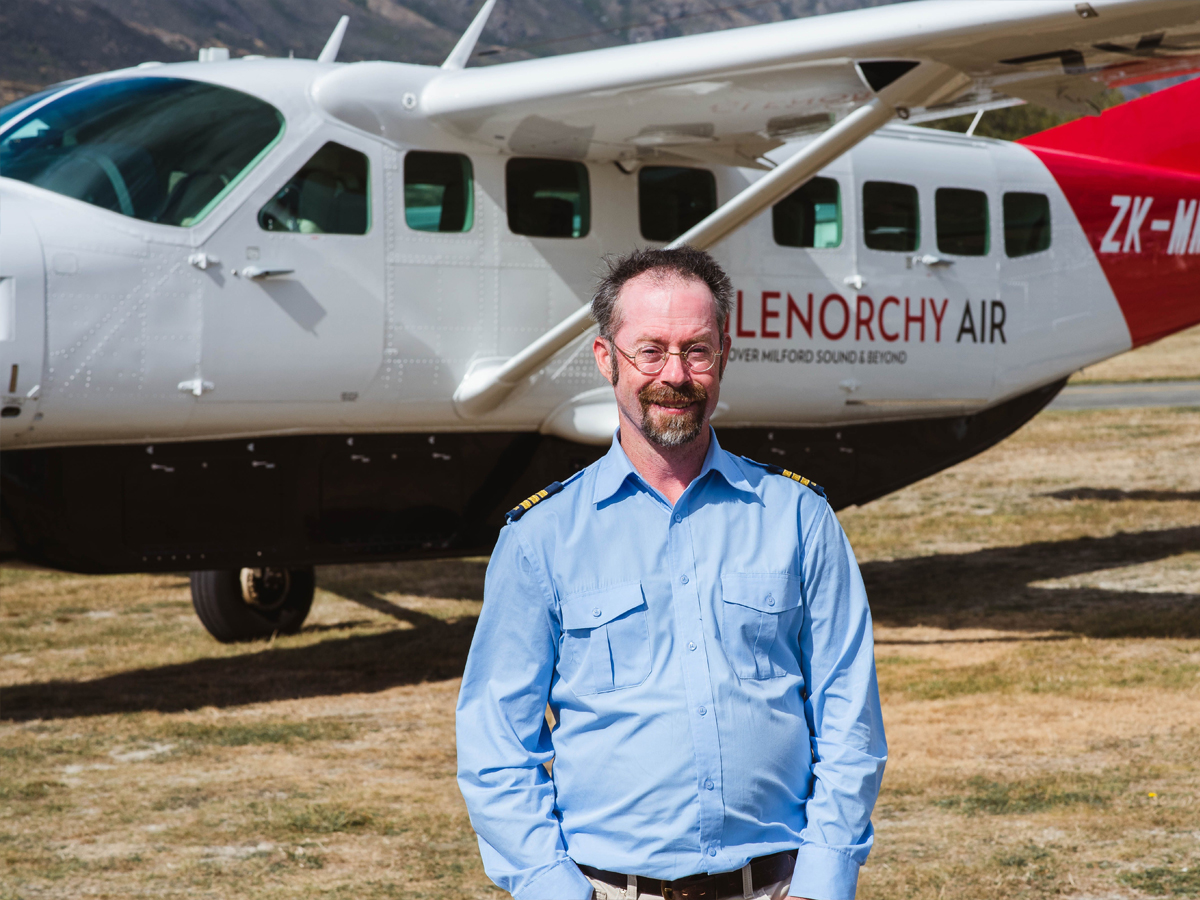
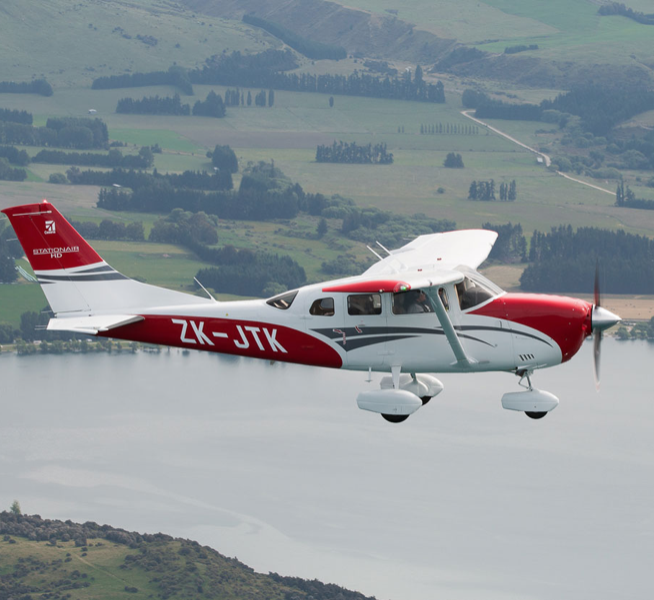


 That way when a weak link breaks on you, ITS A NON-ISSUE. Genius huh???
That way when a weak link breaks on you, ITS A NON-ISSUE. Genius huh??? 
